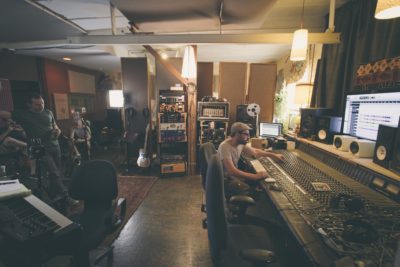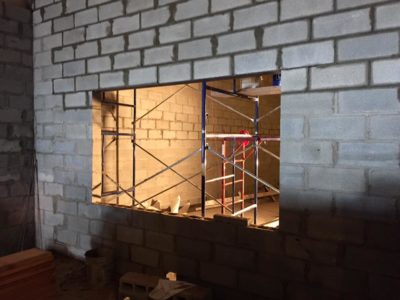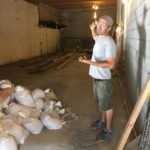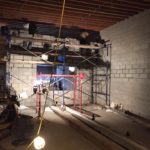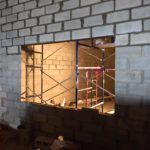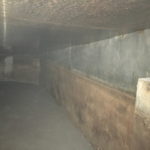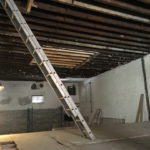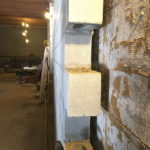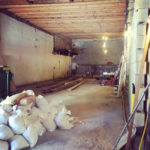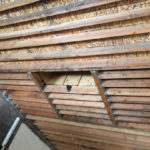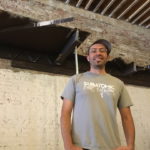New Studio Build: From the Ashes of “The Hook”, Rises a New Brooklyn Recording Studio, “The Bridge”
From The Hook to The Bridge
New York City has long been a home to talented artists, musicians, engineers, producers and world renowned recording studios. But in this age of acceleration, in which recording budgets have shrunk while urban real estate markets have sky rocketed, the era of the large room recording facility has seen a ghost.
The legendary Magic Shop recording studio had its last session in March. MSR, one of the largest recording rooms in midtown Manhattan closed at the end of June. Terminus Recording Studio was terminated at the end of July. With continued uncertainty about the survivability of large-scale layouts in one of the most expensive cities in the nation, what’s left for the NYC recording scene?
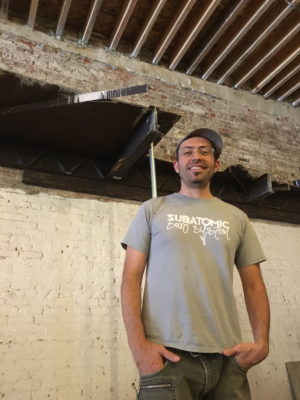
Jeffrey Amon in the huge, raw South Williamsburg space that is now morphing into The Bridge recording studios.
This story is not about Manhattan studios closing down, though. This story is about new studio that will be opening—in fact a pair of them—in the coming months. A new studio with a large live room and multiple control rooms, that marks the continued growth of the Brooklyn recording scene, right across the East River from what was arguably the recording studio capitol of the 20th century.
I met Jeffrey Amon (who goes by “Amon”) by chance.
I had recorded his wife, a singer named Mona Kayhan, back in May. She was telling me how she and her husband were going through the process of relocating their studio after the building was bid out beneath them by a new landlord, and about the immense personal and financial strain that came along with it. I related so closely with her story and wanted to learn about their relocation to Brooklyn, so she organized a meetup between Amon and me.
Amon showed me around his new building site with a smile and the excitement of things to come. He’s in it, deep. Walking around the grounds, it became immediately clear that this was a big and ambitious project, in a huge building.
It is slated to have what so many of us engineers love: A very large live room complete with high ceilings and a window that actually faces the control room.
It is the continuation of a trend already underway, adding to the number of large-scale tracking spaces that have increasingly been cropping up in Brooklyn, including rooms like Studio G, The Bunker, Systems Two and (until it was claimed by Hurricane Sandy) the short-lived South Sound.
The Team
Amon, who is spearheading the building of this new studio, soon-to-be-known as “The Bridge” is a musician first, specializing in West African Djembe and Dun Dun with his group, Analog Players Society.
Through the usual series of events, he became a recording engineer and a music producer along the way, holding on to his passion is for dub music, West African drum music and other drum-focused genres to make something of a name for himself in the musical community he loves to work in most.
Amon’s first studio experience in New York was at The Hook Studio in the neighborhood of Red Hook, Brooklyn. He was passed the torch by then-owners Tony Schloss and Pete Fand, who made their way onto other avenues in music and in family life.
As Amon took over The Hook he had some significant success in the Dub, West African drum and electronic music sides of the industry, working with Sadat X, Afrika Bambaataa, Horace Andy, Lee “Scratch” Perry, Blitz the Ambassador, and Bonobo, until the day he found an eviction notice stuck onto his front door.
The initial lease for The Hook’s location was only made out for a few years, yet the studio stayed on, renting the space on a month-to-month basis for most of 10 years, lasting through the years as other businesses, clubs and venues rose and fell around them.
When the building’s longtime owner met with failing health, he sold the property, and it was not long before the new owners decided it was time to eject the studio, and without much notice. Thanks to the help of an attorney and a judgement in their favor stated, the immediate eviction was overturned and Amon was granted 6 months to vacate the premises. The Hook Studio stayed busy with new sessions for a a little while longer, but alas, in the fall of 2014, he was out.
But this isn’t a story about another studio closing down due to being outbid for what had become a prime piece real estate. This is about the Phoenix: The ashes and the smoke have cleared and so rises a new roof and new stones.
From The Hook to The Bridge
Amon spent about nine months scouting new locations until he found the new address for The Bridge Studios. It was another 14 months of tweaking the lease terms and eventually starting with the demolition and rebuild.
This new space came as a “fixer upper”, to say the least. The entire building’s roof had to be redone as its state of vast disrepair let cascading waterfalls into the building during the snow-melting winter months. One of two 8″ reinforced concrete-and-steel water tubs had to be removed to open up space for the new large live room.
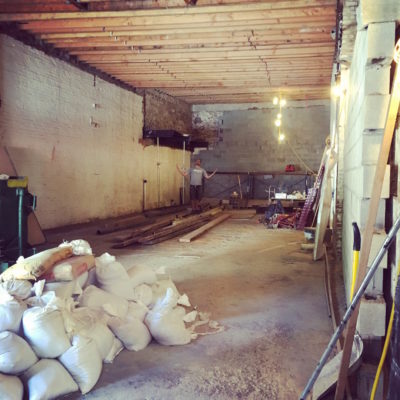
The raw space at the new Bridge studio has come a long way from its beginnings. Structural repairs and demolitions needed to be completed before the building of the studio infrastructure.
Dealing with this kind of structural damage has set the build-out time back, but starting from scratch was just to Amon’s liking: Structurally, the entire facility is designed to be a “building within a building”, as Amon takes every imaginable precaution to keep the sounds inside in and the sounds of city out.
To complete the project, he has teamed up with some fellow producer/engineers who will be partnering in the building with their own new studio construction.
Both studios are to be tie-lined together for flexibility in working across the two space. The vast 4,300 square foot building that will house both studios is T-shaped, allowing it to house two additional production suites, bringing the total number of control rooms to four.
The new Bridge studio, named for the Williamsburg Bridge just blocks away in South Williamsburg, Brooklyn, will house a large live room with a 15-foot ceiling and 874 square feet of space.
An open, airy and unique design that makes use of concrete and salvaged 100-year-old wood and material throughout includes trenches “like the Millennium Falcon”, according to Amon, to stealthily hide cables that might need to run the length of the live room.
Flexibility is the key to The Bridge Studio’s new style. The live room design houses a projector for film scoring with enough space for a small symphony. It is appointed to function as an auditorium for parties and the occasional live recording as well, á la Sound City’s Rage Against the Machine tracking sessions.
Some unique features about the space are the natural echo chambers that are being built into the floor plan, which makes use of a pre-existing water tub that is housed between the two building’s roof and ceiling. Amon says it is, “a 400 square foot, empty, concrete and steel, water tank, hidden between the first floor and the roof. That is going to be our echo chamber.” He describes the sound as a 3-second echo that is somewhere between a hall and a plate. I can’t wait to hear that.
Among other factors, quickly-increasing property values stemming from easy money in the financial industry has allowed too many big landlords to shut down too much recording studio history in New York in recent years, more quickly than they otherwise might.
In light of all the big studio closures across the river in Manhattan, it’s exciting to see an engineer act on his conviction that New York City still needs large-scale recording facilities. It’s exciting to see creativity rise from the ashes and begin to turn a hollowed-out old building into a recording space that helps bring a sense of “big is back” to New York, and more specifically, Brooklyn.
“All of this other bullshit is so that I can make my own music,” says Amon. “That’s it. I got into the studio because I needed a place to practice Djembe. I tried doing it on the Williamsburg Bridge and almost died of smog inhalation. Djembe is loud. It cuts through walls and everything. I needed a place to play and now I’m carrying around a studio,” he laughs.
- Amon shows us around the space.
- Another view of The Bridge as construction continues.
- The control room wall at The Bridge begins to take shape.
- The Echo Chamber
- A second studio space in the works.
- Reinforced concrete walls provide isolation.
- The raw space at the new Bridge studio has come a long way from its beginnings. Structural repairs and demolitions needed to be completed before the building of the studio infrastructure.
- New roof and joists installed
- Jeffrey Amon in the huge, raw South Williamsburg space that is now morphing into The Bridge recording studios.
Please note: When you buy products through links on this page, we may earn an affiliate commission.







